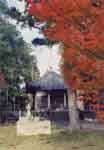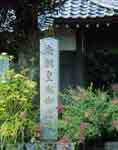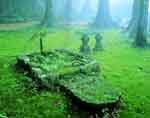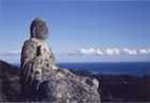Healing - Exhibits - Temple
- Seigantoji Temple
-
 This temple was founded by Ragyo Shonin (the
'Naked Saint') who came from India during the reign of
Emperor Nintoku around 1700 years ago. Ragyo Shonin
endeavoured to train himself in the waters of Nachi Waterfall to reach
enlightenment. Since that time, many monks have come here to
undergo severe training in order to reach some level of
self-realization. This place has also been visited by
numerous emperors, one of which was Emperor Hanayama who
made a pilgrimage of 'Saigoku 33 Kannon Reijo' (the 33
temples of the Kannon goddess pilgrimage in the Kansai
area) after 1000 days of severe spiritual training. He is
said to be the person who revived the pilgrimage of the
'Saigoku 33 Kannon Reijo'. This temple was thriving as a
place of worship and training for the Kumano Gongen until
the Meiji Era. It was then abolished by Meiji government,
later to be rehabilitated. It has now become the first
temple of the 'Saigoku Pilgrimage'. The sound of
pilgrims' bells never ceases to be heard here.
This temple was founded by Ragyo Shonin (the
'Naked Saint') who came from India during the reign of
Emperor Nintoku around 1700 years ago. Ragyo Shonin
endeavoured to train himself in the waters of Nachi Waterfall to reach
enlightenment. Since that time, many monks have come here to
undergo severe training in order to reach some level of
self-realization. This place has also been visited by
numerous emperors, one of which was Emperor Hanayama who
made a pilgrimage of 'Saigoku 33 Kannon Reijo' (the 33
temples of the Kannon goddess pilgrimage in the Kansai
area) after 1000 days of severe spiritual training. He is
said to be the person who revived the pilgrimage of the
'Saigoku 33 Kannon Reijo'. This temple was thriving as a
place of worship and training for the Kumano Gongen until
the Meiji Era. It was then abolished by Meiji government,
later to be rehabilitated. It has now become the first
temple of the 'Saigoku Pilgrimage'. The sound of
pilgrims' bells never ceases to be heard here.
to the top - Fudarakusanji
-
 This temple is believed to have been connected
to Fudarakusan Mountain (Potaraka), a mythical mountain
beyond the sea where the Buddhist deity Kannon is said to
live. From the Heian Era until the middle of the Edo Era,
the chief monks who became 60 would set out to sea alone
from Nachi beach toward the mythical Fudarakusan Mountain
with the best wishes and prayers of their devotees.
Normally these monks would never return, usually dying at
sea. This practice was called 'Fudaraku Tokai'.
Fudarakusan Temple stands next to 'Nagisano Miya Shrine'
alongside the road to Mt. Nachi. This temple is called
Fudarakusan Temple because it is a channel for the
energies of the mythical Fudaraku Mountain. It is said
that the mythical Fudaraku Mountain is beyond the sea to
the south of Nachi and is the pure land and residence of
Kannon. From the Heian Era until the Edo Era, the chief
monk of this temple set out to sea on a small boat when
he became 60. This practice was called 'Fudaraku Tokai',
and is one of the 'Shashin Gyo' trainings in which monks
performed an act of self-sacrifice for the purpose of
human salvation. People entrusted the monks to carry
their prayers for happiness and enlightenment to
Fudarakusan Mountain.
This temple is believed to have been connected
to Fudarakusan Mountain (Potaraka), a mythical mountain
beyond the sea where the Buddhist deity Kannon is said to
live. From the Heian Era until the middle of the Edo Era,
the chief monks who became 60 would set out to sea alone
from Nachi beach toward the mythical Fudarakusan Mountain
with the best wishes and prayers of their devotees.
Normally these monks would never return, usually dying at
sea. This practice was called 'Fudaraku Tokai'.
Fudarakusan Temple stands next to 'Nagisano Miya Shrine'
alongside the road to Mt. Nachi. This temple is called
Fudarakusan Temple because it is a channel for the
energies of the mythical Fudaraku Mountain. It is said
that the mythical Fudaraku Mountain is beyond the sea to
the south of Nachi and is the pure land and residence of
Kannon. From the Heian Era until the Edo Era, the chief
monk of this temple set out to sea on a small boat when
he became 60. This practice was called 'Fudaraku Tokai',
and is one of the 'Shashin Gyo' trainings in which monks
performed an act of self-sacrifice for the purpose of
human salvation. People entrusted the monks to carry
their prayers for happiness and enlightenment to
Fudarakusan Mountain.
to the top - Kamikitayama Village Yakushido
-
 Kami Kitayama Village is a typical mountain
village of the Kumano region. Its main industry is
forestry. Kamikitayama Yakushido Temple can be found in
the center of the village. Yakushido is a deity of
healing. Keitokuji Temple/Yakushido Temple lies on the
highest point in Kawai Ward in KamiKitayama Village and
stands as an highly symbolic icon for the village. From
Yakushido you can enjoy a panoramic view of the mountains
and the village below. This temple's festival, 'Yumi
Matsuri (Bow Festival)', is held on January 8. The young
archers first have to purify themselves in the freezing
cold Kitayama river at dawn before the festival. Yet, it
is said that no archer has ever caught a cold after doing this practice.
Kami Kitayama Village is a typical mountain
village of the Kumano region. Its main industry is
forestry. Kamikitayama Yakushido Temple can be found in
the center of the village. Yakushido is a deity of
healing. Keitokuji Temple/Yakushido Temple lies on the
highest point in Kawai Ward in KamiKitayama Village and
stands as an highly symbolic icon for the village. From
Yakushido you can enjoy a panoramic view of the mountains
and the village below. This temple's festival, 'Yumi
Matsuri (Bow Festival)', is held on January 8. The young
archers first have to purify themselves in the freezing
cold Kitayama river at dawn before the festival. Yet, it
is said that no archer has ever caught a cold after doing this practice.
to the top - Yunomine Yakushi
-
 Yunomine Onsen is well known as 'the oldest
hotspring in Japan'. It is said that Ooadonosukune, who
was the governor of Kumano around the 3rd and 4th
century, discovered the hotspring. Yunomine Yakushi is
the deity who protects this hot spring. 'Yunomine
Yakushi' resides in the Tokoji Temple, centrally located
in the village where 'Yunomine Onsen' is found. The
hotspring here is reputed to have a 'wild and natural'
taste. In the photo you can see a hole in the rock statue
on the left chest area. The rock is a natural formation
which if you look closely takes the shape of a human
form. There is a legend which tells of the hot spring
first gushing forth from this hole in the rock, called
Yakushi Statue. Because of this legend the Yakushi has
also come to be called 'Yunomune' (the chest of hot
water). Later this evolved into its present name of
'Yunomine'.
Yunomine Onsen is well known as 'the oldest
hotspring in Japan'. It is said that Ooadonosukune, who
was the governor of Kumano around the 3rd and 4th
century, discovered the hotspring. Yunomine Yakushi is
the deity who protects this hot spring. 'Yunomine
Yakushi' resides in the Tokoji Temple, centrally located
in the village where 'Yunomine Onsen' is found. The
hotspring here is reputed to have a 'wild and natural'
taste. In the photo you can see a hole in the rock statue
on the left chest area. The rock is a natural formation
which if you look closely takes the shape of a human
form. There is a legend which tells of the hot spring
first gushing forth from this hole in the rock, called
Yakushi Statue. Because of this legend the Yakushi has
also come to be called 'Yunomune' (the chest of hot
water). Later this evolved into its present name of
'Yunomine'.
- YojiYakushi Temple
Yakushi Nyorai is the main deity
of the 'Tokoji Temple' in the village of 'Yunomine Onsen'. The
existence of this healing deity in the region of Kumano is highly
symbolic and is linked to the notion of Kumano as a land of
healing and rebirth. A well-known legend also exists about a man
called Oguri Hangan who recovered from a terminal disease by
bathing in the waters of this hotspring. The existence of this
healing deity in the region of Kumano is highly symbolic and is
linked to the notion of Kumano as a land of healing and rebirth.
A well-known legend also exists about a man called Oguri Hangan
who recovered from a terminal disease by bathing in the waters of
this hotspring


to the top
-
- Takigawa Temple
-
 Many legends and stories remain in the mountain
villages regarding the tragic history of the Nanbokucho
Era, when the North and South Dynasties were at war.
Takigawa temple is famous as the place where the Nancho
Prince was murdered after he went into hiding there. The
temple's crest is the same as that of the Japanese Royal
Family, a chrysanthemum with a golden aura. A certain
degree of local pride still flows from this fact.
Many legends and stories remain in the mountain
villages regarding the tragic history of the Nanbokucho
Era, when the North and South Dynasties were at war.
Takigawa temple is famous as the place where the Nancho
Prince was murdered after he went into hiding there. The
temple's crest is the same as that of the Japanese Royal
Family, a chrysanthemum with a golden aura. A certain
degree of local pride still flows from this fact.
to the top - Kofukuji Temple
-
 Kumano area has a lot of places that are famous
in connection with Nancho (the Southern Dynasty). Kofuku
Temple is one such place. It is famous for continuing the
Bon Dance tradition every August where those who have
passed on to the beyond after death are honoured and
remembered. The Temple Bon Dance is known for its unique
dance style known as 'Jajakku'. The Jajakku has a special
atmosphere created by the use of drums and bells ringing
in rhythm with the Bon chanting and dancing.
Kumano area has a lot of places that are famous
in connection with Nancho (the Southern Dynasty). Kofuku
Temple is one such place. It is famous for continuing the
Bon Dance tradition every August where those who have
passed on to the beyond after death are honoured and
remembered. The Temple Bon Dance is known for its unique
dance style known as 'Jajakku'. The Jajakku has a special
atmosphere created by the use of drums and bells ringing
in rhythm with the Bon chanting and dancing.
to the top - Amidaji Temple
-
 After a long climb up a mountain near Nachi Falls,
you will find Myohozan Amidaji Temple which is also called
Nyonin Koya ('sacred mountain for women'). There is a
little altar surrounded by stones behind the main
building. Ojo Shonin is mentioned in Japanese historical
records as a monk who undertook severe practices in
Myohozan Amidaji Temple above the Nachi Waterfall. His
last practice was his final self-sacrifice. He ate
nothing except pine needles, wore paper clothes, sat on
the fire wood facing the west and burned himself. The
site where he sacrificed himself can be found behind
Myohozan Amidaji Temple.
After a long climb up a mountain near Nachi Falls,
you will find Myohozan Amidaji Temple which is also called
Nyonin Koya ('sacred mountain for women'). There is a
little altar surrounded by stones behind the main
building. Ojo Shonin is mentioned in Japanese historical
records as a monk who undertook severe practices in
Myohozan Amidaji Temple above the Nachi Waterfall. His
last practice was his final self-sacrifice. He ate
nothing except pine needles, wore paper clothes, sat on
the fire wood facing the west and burned himself. The
site where he sacrificed himself can be found behind
Myohozan Amidaji Temple.
to the top - Jinnoji Temple
-
 This mountain has Jinnoji Temple
(which is said to have been founded by Kobodaishi) and Kasaneyama Shrine
and has been a center of people’s respect since ancient times. The view
from the top of this mountain is famous as it looks over the Pacific
Ocean, Nachi Range, Oshima Island and Kushimoto. The name Kaseyama derives
from the fact that it seems like you are looking over a layered sea of
mountains. You can follow the Kumano Kodo Old Road from the foot of this
mountain and imagine how Kobodaishi and the many Kumano Mode pilgrims
walked the same road more than 1200 years ago.
This mountain has Jinnoji Temple
(which is said to have been founded by Kobodaishi) and Kasaneyama Shrine
and has been a center of people’s respect since ancient times. The view
from the top of this mountain is famous as it looks over the Pacific
Ocean, Nachi Range, Oshima Island and Kushimoto. The name Kaseyama derives
from the fact that it seems like you are looking over a layered sea of
mountains. You can follow the Kumano Kodo Old Road from the foot of this
mountain and imagine how Kobodaishi and the many Kumano Mode pilgrims
walked the same road more than 1200 years ago.
to the top
 Kami Kitayama Village is a typical mountain
village of the Kumano region. Its main industry is
forestry. Kamikitayama Yakushido Temple can be found in
the center of the village. Yakushido is a deity of
healing. Keitokuji Temple/Yakushido Temple lies on the
highest point in Kawai Ward in KamiKitayama Village and
stands as an highly symbolic icon for the village. From
Yakushido you can enjoy a panoramic view of the mountains
and the village below. This temple's festival, 'Yumi
Matsuri (Bow Festival)', is held on January 8. The young
archers first have to purify themselves in the freezing
cold Kitayama river at dawn before the festival. Yet, it
is said that no archer has ever caught a cold after doing this practice.
Kami Kitayama Village is a typical mountain
village of the Kumano region. Its main industry is
forestry. Kamikitayama Yakushido Temple can be found in
the center of the village. Yakushido is a deity of
healing. Keitokuji Temple/Yakushido Temple lies on the
highest point in Kawai Ward in KamiKitayama Village and
stands as an highly symbolic icon for the village. From
Yakushido you can enjoy a panoramic view of the mountains
and the village below. This temple's festival, 'Yumi
Matsuri (Bow Festival)', is held on January 8. The young
archers first have to purify themselves in the freezing
cold Kitayama river at dawn before the festival. Yet, it
is said that no archer has ever caught a cold after doing this practice. 

 Kumano area has a lot of places that are famous
in connection with Nancho (the Southern Dynasty). Kofuku
Temple is one such place. It is famous for continuing the
Bon Dance tradition every August where those who have
passed on to the beyond after death are honoured and
remembered. The Temple Bon Dance is known for its unique
dance style known as 'Jajakku'. The Jajakku has a special
atmosphere created by the use of drums and bells ringing
in rhythm with the Bon chanting and dancing.
Kumano area has a lot of places that are famous
in connection with Nancho (the Southern Dynasty). Kofuku
Temple is one such place. It is famous for continuing the
Bon Dance tradition every August where those who have
passed on to the beyond after death are honoured and
remembered. The Temple Bon Dance is known for its unique
dance style known as 'Jajakku'. The Jajakku has a special
atmosphere created by the use of drums and bells ringing
in rhythm with the Bon chanting and dancing.  After a long climb up a mountain near Nachi Falls,
you will find Myohozan Amidaji Temple which is also called
Nyonin Koya ('sacred mountain for women'). There is a
little altar surrounded by stones behind the main
building. Ojo Shonin is mentioned in Japanese historical
records as a monk who undertook severe practices in
Myohozan Amidaji Temple above the Nachi Waterfall. His
last practice was his final self-sacrifice. He ate
nothing except pine needles, wore paper clothes, sat on
the fire wood facing the west and burned himself. The
site where he sacrificed himself can be found behind
Myohozan Amidaji Temple.
After a long climb up a mountain near Nachi Falls,
you will find Myohozan Amidaji Temple which is also called
Nyonin Koya ('sacred mountain for women'). There is a
little altar surrounded by stones behind the main
building. Ojo Shonin is mentioned in Japanese historical
records as a monk who undertook severe practices in
Myohozan Amidaji Temple above the Nachi Waterfall. His
last practice was his final self-sacrifice. He ate
nothing except pine needles, wore paper clothes, sat on
the fire wood facing the west and burned himself. The
site where he sacrificed himself can be found behind
Myohozan Amidaji Temple.  This mountain has Jinnoji Temple
(which is said to have been founded by Kobodaishi) and Kasaneyama Shrine
and has been a center of people’s respect since ancient times. The view
from the top of this mountain is famous as it looks over the Pacific
Ocean, Nachi Range, Oshima Island and Kushimoto. The name Kaseyama derives
from the fact that it seems like you are looking over a layered sea of
mountains. You can follow the Kumano Kodo Old Road from the foot of this
mountain and imagine how Kobodaishi and the many Kumano Mode pilgrims
walked the same road more than 1200 years ago.
This mountain has Jinnoji Temple
(which is said to have been founded by Kobodaishi) and Kasaneyama Shrine
and has been a center of people’s respect since ancient times. The view
from the top of this mountain is famous as it looks over the Pacific
Ocean, Nachi Range, Oshima Island and Kushimoto. The name Kaseyama derives
from the fact that it seems like you are looking over a layered sea of
mountains. You can follow the Kumano Kodo Old Road from the foot of this
mountain and imagine how Kobodaishi and the many Kumano Mode pilgrims
walked the same road more than 1200 years ago.